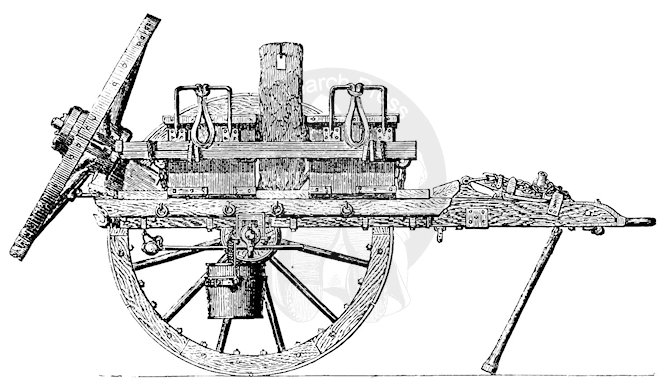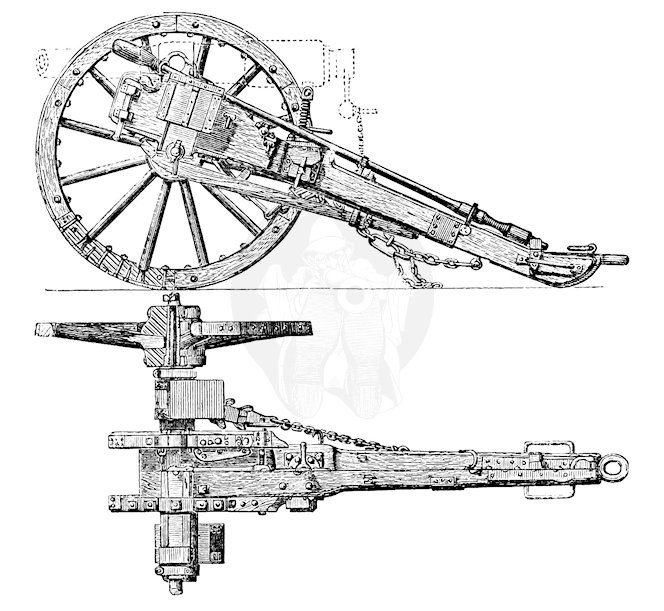You are here: Home > British Military > Ordnance
Armstrong Guns > Gun Factory Department > British Service Guns
The great display in the British division of Class 11 is made by the CONTRIBUTIONS FROM THE WAR DEPARTMENT, in all its divisions of service. From the Royal Carriage Department there is a very large collection of gun carriages for garrison, naval, and field service, with all their adjuncts, including all the recent alterations and improvements made on these in connection with the Armstrong guns. All are superbly got up – the material magnificent, the workmanship perfect. The timber has all been left unpainted, as was right and proper; but we must object to the gingerbread style in which the ash and oak have been glittered over with varnish. How much better it all would have looked to the practical eye, if painted the honest lead colour of service, with a few spots left untouched to show the quality of the wood, or the whole left uncovered. Nothing can look more inappropriate, than the great garrison carriage and slide (in the centre nave) of the largest Armstrong, got up, as it is, like a monstrously ugly piece of clumsy cabinetmaker’s work – false, too, on its front – for this is not the style in which the work of Woolwich carriage yard is turned out – though its quality is equally good, and far more suitable to the rough realities of war.
Few who have not had the advantage and pleasure of seeing the carriage department fully at work, have any idea of the extent to which wood-working tools have been brought to bear there. Nearly everything requiring repetition is now made by automatic machinery; and whereas, in the old days of Vittoria, a battery of field artillery per month, would have been a prodigious effort, at present a complete battery could be completed every third day.

Fig. 631: Armstrong’s New Gun Platform, suitable to any Radius, for either Casemate or Dwarf – Elevation
From authentic drawings never before published, and officially supplied us by the Minister of War, and which we thus beg to acknowledge, we are enabled to lay before our readers two of these carriages, which may be viewed as types, viz., in Fig. 631, the carriage and platform, either dwarf or for casemates, of the heavy natures of Armstrong guns; in Fig. 632, the ammunition waggon; and in Figs. 633, 634, the field carriage for the 12-pounder and other light natures of Armstrong field gun. The former carriage and platform slide, have been as far as possible, adapted to the new models, for obvious reasons, with some improvements as to adjustments, &c.

Fig. 632: Ammunition Waggon for 12-pounder Armstrong Battery.
In the field gun carriages, the most remarkable improvement, introduced with the Armstrong guns, has been that by which a fine screw adjustment in azimuth, is given to the gun without shifting the carriage. The trunnions of the gun, in place of dropping directly into bearings formed in the cheeks of the trail piece as usual, are received in two plummer blocks, connected together by a bent cross piece of wrought-iron at the centre, and middle of horizontal motion, secured by a vertical axis or pin into the trail timber; a lever coming backwards at right angles to this, forged in one with it, is moved by a horizontal screw and hand wheel crossing the trail piece, the vertical elevating and depressing screw movement being continued as formerly. The cheeks of the carriage sustain the gun against recoil, and bear its weight at the trunnions, but leave the trunnion frame and gun free to move several degrees horizontally.

Fig.63. and Fig. 634: Block Trail Carriage Armstrong Gun, 12-pounder – Section and Plan.
There are several other minor changes from the old carriages, either necessitated by the nature of the new gun, or with special aims of amelioration. The small independent motion in azimuth is very far from being a useless refinement.
From the Laboratory and the Chemical Department are shown shot, shells, cartridges, fuzes, priming tubes, and the endless paraphernalia of destruction – explosive, incendiary, and penetrative – and both of the old smooth bore patterns and of the Armstrong’s, and of all natures, from the huge 36-inch shell of the great mortars, down to the grape of the 4-pounder.
Of these, some of the most interesting are the exquisitely finished and varied forms of ammunition for the Armstrong guns, including the segment shell and the modifications of, time and concussion fuzes, devised for these.
In this branch of the display we remarked with disappointment a bit of unworthy, and, where so much challenges admiration, most uncalled for clap-trap. A beehive-shaped vessel of a couple of feet across the mouth, is painted white inside, and stuck all over its interior by hand, with fragments of Armstrong shells as thick as almonds upon a Christmas pudding; and this is declared to represent the effects of such a shell exploded in such a space and vessel. Even ignorance can hardly be so dense as to stare with wonder only, at this production, with which doubtless the inventor of these shells has had nothing to do.
The chemical department exhibits Dr. Abel’s very elegant fuzes for exploding mines, &c., by inductive electricity. The eye alone, however, imperfectly appreciates these contrivances, based upon a new chemico-physical fact, discovered sometime since by the chemist to the war department.